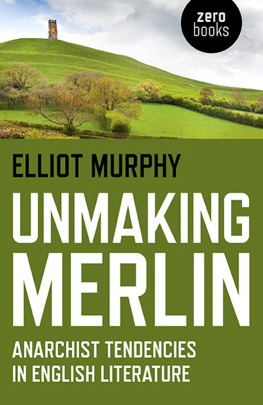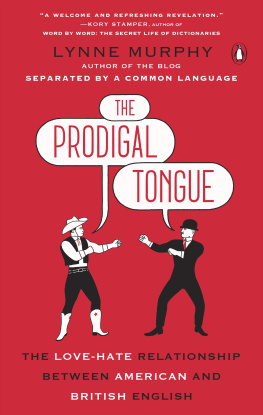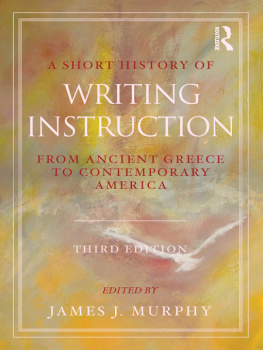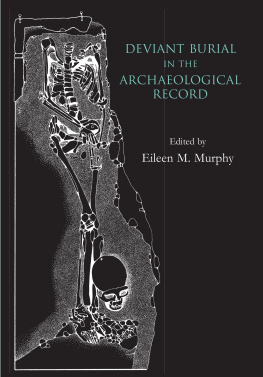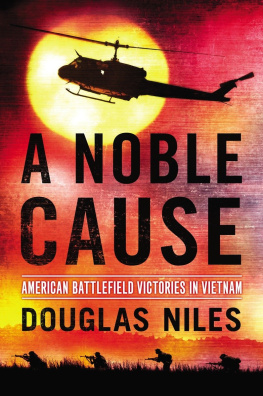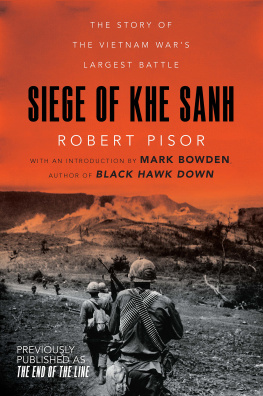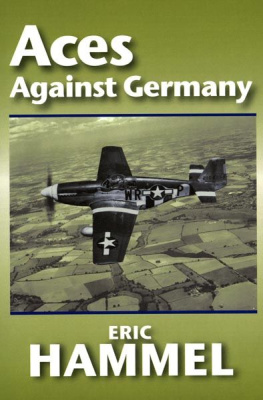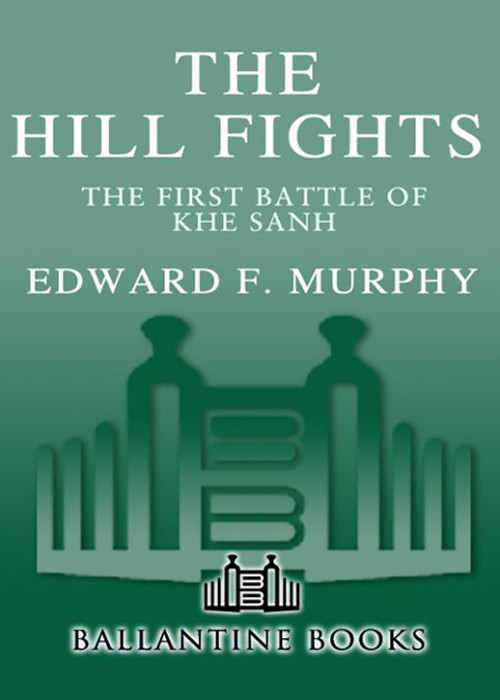

Table of Contents
Dedicated to those who fought at Khe Sanh and those
whose names are on panels 16E, 17E, 18E, and 19E
at the Vietnam Veterans Memorial
More praise for The Hill Fights
Fans of military history, especially involving the Vietnam War, will want to check out this detailed, dramatic account of the disastrous first assault on Khe Sanh....Like Harold G. Moores We Were Soldiers Once...and Young, which chronicles a clash between American troops and far superior enemy forces, this is the story of brave soldiers persevering against terrible odds....[Murphy] is a graceful writer, capturing every nuance, bringing every moment alive. Its an important story, told with compassion and intelligence.
Booklist
From the opening ambush of Sergeant Harpers patrol of the 9th Marines, Murphy brings the reader into the firefights in a manner that will not fail to hold the attention of specialist and student alike.
Library Journal
Books published by The Random House Publishing Group are available at quantity discounts on bulk purchases for premium, educational, fund-raising, and special sales use. For details, please call 1-800-733-3000.
Acknowledgments
A book of this nature and scope could not have been written without the assistance and cooperation of a wide variety of people. I would like to express my sincere thanks to those who helped bring this project to fruition:
Bob Kane and E. J. McCarthy at Presidio Press not only believed in the project but recognized the importance of adding the story of the Khe Sanh Hill Fights to the collection of Vietnam War literature.
The Rev. Ray Stubbe, of Wauwatosa, Wisconsin, was a Navy chaplain with the 26th Marines during the Khe Sanh siege in 1968. Since that time he has devoted untold thousands of hours to research that battle and other events relating to Khe Sanh and has earned a well-deserved reputation as the authority on the subject. His hard work resulted in the publication of the definitive Valley of Decision, which not only covers the siege but also provides considerable background material on the United States militarys involvement at Khe Sanh, including the Hill Fights. Ray is also the founder of the Khe Sanh Veterans Association, a veterans group with an annual meeting open to anyone who ever served in and around Khe Sanh. From the first time I contacted Ray about my project, he unselfishly provided every bit of help and assistance I needed. He supported my efforts and encouraged Hill Fights veterans to respond to my request for interviews. Ray routinely provided documents from his archives that even the Marine Corps Historical Center could not. When I needed a photograph, Ray provided it. He devoted some of his rare spare time to reviewing the manuscript and helping me over rough spots. Without his support, help, and encouragement, I could not have written this book.
Retired Marine gunner Dick Shoemaker, a former platoon commander in Kilo 3/3 at the Hill Fights, also read the manuscript. His unparalleled assistance not only helped keep the events straight, it also aided in the usage of proper terminology and nomenclature.
Retired Marine Corps colonel George Navadel, who served during the Hill Fights time period as the S-4 of the 9th Marines, provided background information on that unit and Kilo and Mike 3/9 that gave me considerable insight into the command structure.
Retired Marine Corps major general Matt Caulfield, the S-3 of 3/26 during the siege, graciously consented to review my chapter on the siege to ensure that I had not made any mistakes.
Cathy Leroy, the famed combat photojournalist, unhesitatingly volunteered to let me use the famous series of photographs she took on 30 April 1967.
My wife, Kay, who devoted long hours to typing the manuscript from my handwritten drafts, and never complained about all the corrections, additions, deletions, and changes that followed, deserves the highest accolades for her support and understanding.
Mostly, though, I extend my thanks, deepest gratitude, and appreciation to the veterans of the Hill Fights whom I contacted. All but one of them immediately agreed to revisit and recount the events they experienced more than thirty years ago, even though doing so was painful and emotional for many of them. They not only shared their personal stories, they sent me letters they had written home about the Hill Fights, provided copies of personal accounts of the fight that they had composed over the years, copied photographs, and gave me the names of buddies who had fought with them. I cannot thank them enough for sharing so much with me.
The fighting around Khe Sanh in the spring of 1967 has long been overshadowed by the highly publicized siege of Khe Sanh during the following year. As a result, this battle is rarely mentioned in accounts of the war. Very few Vietnam War historians are aware of the significance and brutality of the battles; fewer still knew of the scandalous failures of the newly issued M16 rifle that caused so many casualties.
I am proud and honored to be the one to tell this story. Any errors or mistakes in the account are mine, and mine alone.
Semper Fidelis!
Edward F. Murphy
Preface
Lance Corporal Steven Wright moved cautiously up the narrow trail. Behind him the rest of the Marine combat patrol snaked downhill for more than a hundred meters, reaching nearly to the base of the knoll. Dense stands of elephant grass covered the hillside, rising above Wrights head and limiting his view to less than ten meters off the trail. No breeze penetrated the foliage; no wind stirred the sharp-edged stalks of grass. Heavy, humid air hung over the hill. The hill was not high and the trail was not steep, but the effort of walking uphill carrying close to fifty pounds of equipment took its toll on Wright. Though it was only midmorning, dark patches of sweat already stained his utilities. He paused to wipe the sweat from his eyes. A few meters ahead of him, the trail turned sharply before cresting the hill. Wright stepped around the curve and froze. There, not thirty meters away, casually strolled three Vietnamese men. Before Wright could react, he heard a rustling sound to his left. He glanced over and caught a fleeting glimpse of a slightly built man wearing a khaki-colored uniform who disappeared into the brush. Nervously shifting his 12-gauge shotgun to his left hand, Wright turned and whispered hoarsely to the patrol leader behind him, Gooks!
Sergeant Donald E. Harper stopped in midstride. He hastily signaled the members of his thirteen-man patrol to get down. In the three weeks that he and the rest of Bravo Company, 1st Battalion, 9th Marines (Bravo 1/9) had been at Khe Sanh, he had led more than a half dozen patrols into the surrounding mountains. They had not spotted any enemy soldiers before.
With his heart pounding rapidly, Harper crept forward. He found Wright kneeling in the thick elephant grass alongside the path. In hurried whispers Wright told Harper what he had seen. No, he responded to Harpers questions, he didnt think hed been spotted. Yes, they were definitely Vietnamese. No, he hadnt noticed if they were armed.
Harper looked around. He knew the area well. The hill they were on sat less than 2,000 meters straight out from the western end of Khe Sanhs airstrip. He had led several earlier patrols across it. In fact, he and his men had eaten their lunch rations near this spot just a few days earlier. Not more than 150 meters high, the little hill guarded the approaches to the larger hill masses rising to the northwest. The closest one, Hill 861, which was perched ominously less than two kilometers away, looked straight down on the Marines base. If there were enemy soldiers here, Harper reasoned, they must have come from there. He decided they had probably been reconnoitering Bravos perimeter positions around the base.
Next page


